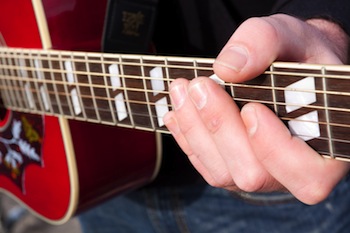To create a progression that sounds fresh, try starting with something strong and predictable, and then modify it. Here are 5 ways to do that.
_____________
Download “The Essential Secrets of Songwriting” 6-Ebook Bundle. 11 Songwriting Principles That Will Turn Your Writing Around – Guaranteed.
_____________
 Most great songs are built on chord progressions that sound, on their own, quite predictable and almost boring. This often comes as a big surprise to many songwriters, who often think that chords need to stand out and grab people’s attention.
Most great songs are built on chord progressions that sound, on their own, quite predictable and almost boring. This often comes as a big surprise to many songwriters, who often think that chords need to stand out and grab people’s attention.
But most of the time, the truth is that the elements that really stand out and make a difference in most powerful music are the melody and the lyrics. Your most important duty as a songwriter, at least with regard to chord progressions, is to get them working, not necessarily demanding the audience’s full focus.
Having said that, there are times when it would be nice to create a progression that sounds fresh or somehow innovative. So let’s take a look at what can be done to spruce up an otherwise tedious progression.
Let’s take a standard one that probably has been used in thousands of songs:
C G Am F C
What can you do to it that might make it stand out a bit more? Try these ideas:
- Use chord inversions. To invert a chord means to put a note other than the root of the chord at the bottom. Often you’ll do this to smooth out a jumpy bass line. With a bit of experimenting, you might come up with this: C G/B Am F C (A note after a slash represents the bass note).
- Use a bass pedal point. A pedal point means that the same bass note is held while the chords change above it. Most of the time you’ll find that either the tonic (I) or dominant (V) provides a satisfactory pedal, but feel free to experiment. For example try the sample progression with the bass holding a C (C G/C Am/C F/C C), but you might find a pedal on the 4th note to give you interesting results: C/F G/F Am/F F C.
- Use an inverted pedal. Like a bass pedal, an inverted pedal keeps an upper note constant while the chord changes around it. You hear this effect in The Supremes “You Keep Me Hangin’ On.” So try playing the sample progression on guitar or keyboard, keeping a constant note, perhaps a high C or a high E. [LISTEN to a sample of the chord progression with an inverted pedal E above it]. (Opens in a new browser window or tab).
- Use a modal mixture. To give a brief description, modal mixtures are triads that belong to the list of minor chords if you’re in a major key, and vice versa. To make this simple, try experimenting by changing major chords to minor. The most common type in pop music genres is the minor-IV chord: C G Am Fm C, but you can also try a minor V (C Gm Am F C), or for something more creative, also try a flat-VI in place of Am: C G Ab Fm C (For a more complete description of modal mixtures, read this.)
- Use suspensions. A suspension occurs when you “hold a note up” before allowing it to descend to form a simple triad. The most common type is the sus4. A Gsus4 gives us these notes: G-C-D. That chord then normally resolves to a simple G triad: G-B-D. So try breathing a bit of freshness into this progression by creating suspensions: C Gsus4 G Am Fsus4 F C. For the Fsus4, you can either keep the key signature intact, which gives you the notes F-B-C, resolving to F-A-C. Or you could try adding a flat to the B, giving you this: F-Bb-C, resolving to F-A-C.
The benefit of doing these sorts of things (over trying to create a progression from scratch that strays from the norm) is that you know the original progression works. The modifications that result from the ideas listed above simply change the “flavour” of the chords, simply making a predictable progression sound a bit fresher.
_________________
 Get “The Essential Secrets of Songwriting” 6-eBook Bundle (PDF format) and you’ll learn much, much more about how to write great melodies, chord progressions, and every other aspect of songwriting. Now with a free 7th eBook. Read more..
Get “The Essential Secrets of Songwriting” 6-eBook Bundle (PDF format) and you’ll learn much, much more about how to write great melodies, chord progressions, and every other aspect of songwriting. Now with a free 7th eBook. Read more..
Readable on laptop/desktop, iPad, Kindle, and any other PDF-reading device.










Pingback: Writing Memorable Melodies | Pghboemike's Blog
Great Post as usual,are your books available via KINDLE please
Hi Jack – Yes, my songwriting ebooks are in PDF format, readable on any PDF-reading device. The download is a zip file, so you can either download them onto a laptop or desktop, expand them and send them to your Kindle, or write me after purchase and I’ll send you full-version PDFs right away.
Cheers, and glad you find the post helpful.
-Gary